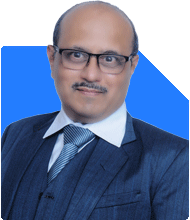Milind Vadjikar | Answer |Ask -Follow
Insurance, Stocks, MF, PF Expert - Answered on Oct 24, 2024
He has a mechanical engineering degree from Government Engineering College, Sambhajinagar, and an MBA in international business from the Symbiosis Institute of Business Management, Pune.
With over 16 years of experience in stock investments, and over six year experience in investment guidance and support, he believes that balanced asset allocation and goal-focused disciplined investing is the key to achieving investor goals.... more

Dear Arora Sir, I am 51 yr old , Staying in NCR (Rental); Old Parental House in Lucknow (Vacant, To be sold later, Approx Cost - 60 L); *18.90 L PA salary (In hand), Expenses 10.0L PA (Inclusive of House expenses, Electricity , House rent , Term Insurance Premium, Medical + super Top up Premium, Car Loan for next 32 month etc), 2 Term plan - 1.75 Cr (Cummulative SI) ; Daughter (1 no, 20 yrs) - Higher Education & Marriage, Son (1 No, 13 yrs) - Higher Education & Marriage; New house to purchase (In Lucknow in next 5-6 years after selling the existing Parental house , Budget: 75L - 85L);; * Investments : PPF (25th Term Running): 24 L ; Sukhanya (Daughter's ) : 4.0L; Shares : 10.0 L. I also earn approx 1.0 Lacs / yr from Interest + Dividends which is again reinvested in SIP. * Monthly investment is 72K in Mutual Fund SIP. SIP in Progress: DSP Elss D/G - 8000/- ; Nippon Mid Cap D/G - 5000/-; Nippon Multi Cap D/G - 8000/-; Parag Flexi Cap D/G - 5000/- ; Quant Elss D/G - 8000/- ; Mirae Elss D/G - 6000/- ; ICICI Pru Val Disc D/G - 7000/-; HDFC Def D/G - 5000/-; HDFC Flexi Cap D/G - 5000/-; HDFC Mfging D/g - 5000/-; HDFC Mid Cap opportunity D/G - 5000/- ; HDFC Top 100 D/G - 5000/- ; My choice of selecting MF House & Scheme is mainly word of mouth / Google etc.. not much of research !! * SIP Completed lying dormant (Units available) : Axis Bluechip D/G - 4287 units; Axis Elss D/G - 8049 units; Axis Elss D/IDCW - 4342 units; Sundaram Mid Cap D/G - 1123 units; UTI Nifty 50 index D/G - 3021 units ; ABSL Frontline Equity D/G - 4763 units ; DSP Top 100 D/G - 2203 units ; HDFC Hybrid - 5862 units; HDFC Top 100 D/IDCW - 3640 units ; HSBC ELSS R/IDCW - 1840 units ; HSBC ELSS D/IDCW - 259 units ; ICICI Pru Bluechip D/G - 4267 units ; ICICI Pru Multi Asset D/G - 1775 units ; Mirae Large & Mid Cap D/G - 3395 units ; Mirae ELSS D/IDCW - 8861 units; Nippon Large Cap D/G - 9915 units; Nippn Elss D/IDCW - 12705 units ; Quantum Long Term Equity D/G - 9702 units; I have been Investing from 1998 onwards in SIP ; Till now total invested in SIP : 66L ;; current value is 1.74 Cr). My Wish List : To make approx 10CR after 9 years (Retirement); So please Suggest / Guide me , how to move forward with current investments or any restructure is reqd. Thanks in Advance.
Your corpus value 9 years hence will be 7.80 Cr.
This working includes sip corpus, ppf, ssy, stock holding, dividend/interest reinvestment in SIPs, dormant sips future value after 9 years and parental house current value.
You may redeem the IDCW scheme dormant SIPs and reinvest the proceeds in current sip funds equally as lumpsum.
Regarding existing SIP funds, I suggest you to remove thematic funds like HDFC defence and HDFC manufacturing funds and redirect those SIPs into PPFAS flexicap fund and HDFC Top 100 fund.
Please confirm the EPF and NPS, if any, corpus available to you which can supplement the corpus gap of 2.2 Cr.
The prospect of sip enhancement or top-up to meet target shortfall is prohibitively high hence unfeasible.
Please feel free to revert.
Happy Investing;
You may like to see similar questions and answers below
Ramalingam Kalirajan |10891 Answers |Ask -Follow
Mutual Funds, Financial Planning Expert - Answered on Oct 01, 2024
Ramalingam Kalirajan |10891 Answers |Ask -Follow
Mutual Funds, Financial Planning Expert - Answered on Oct 03, 2024
Ramalingam Kalirajan |10891 Answers |Ask -Follow
Mutual Funds, Financial Planning Expert - Answered on Nov 04, 2024
Ramalingam Kalirajan |10891 Answers |Ask -Follow
Mutual Funds, Financial Planning Expert - Answered on May 07, 2025
Nitin Narkhede | Answer |Ask -Follow
MF, PF Expert - Answered on Jul 02, 2025
Radheshyam Zanwar |6746 Answers |Ask -Follow
MHT-CET, IIT-JEE, NEET-UG Expert - Answered on Dec 15, 2025
Ramalingam Kalirajan |10891 Answers |Ask -Follow
Mutual Funds, Financial Planning Expert - Answered on Dec 15, 2025
Ramalingam Kalirajan |10891 Answers |Ask -Follow
Mutual Funds, Financial Planning Expert - Answered on Dec 15, 2025
Ramalingam Kalirajan |10891 Answers |Ask -Follow
Mutual Funds, Financial Planning Expert - Answered on Dec 15, 2025
Samraat Jadhav |2508 Answers |Ask -Follow
Stock Market Expert - Answered on Dec 15, 2025
Ramalingam Kalirajan |10891 Answers |Ask -Follow
Mutual Funds, Financial Planning Expert - Answered on Dec 15, 2025
Reetika Sharma |425 Answers |Ask -Follow
Financial Planner, MF and Insurance Expert - Answered on Dec 15, 2025
Radheshyam Zanwar |6746 Answers |Ask -Follow
MHT-CET, IIT-JEE, NEET-UG Expert - Answered on Dec 15, 2025
Reetika Sharma |425 Answers |Ask -Follow
Financial Planner, MF and Insurance Expert - Answered on Dec 15, 2025
Ramalingam Kalirajan |10891 Answers |Ask -Follow
Mutual Funds, Financial Planning Expert - Answered on Dec 15, 2025


























.jpg)